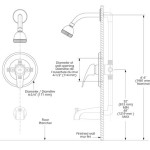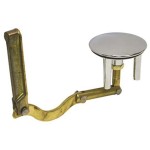Do You Need A Vent For A Bathtub Drain? Understanding Plumbing Requirements
The question of whether a bathtub drain requires a vent is a crucial one in plumbing, impacting the efficiency and functionality of the drainage system. Often, homeowners and even some less experienced plumbers grapple with this requirement, leading to installations that may not comply with plumbing codes or perform optimally. Understanding the purpose of vents, how they interact with drainage systems, and the specific requirements for bathtubs is essential for ensuring a properly functioning and compliant plumbing installation.
Plumbing vents are integral components of a building's drainage system. They are designed to regulate air pressure within the drainpipes, preventing a phenomenon known as "siphonage." When water rushes through a drainpipe, it can create a vacuum that sucks water from the P-traps of other fixtures connected to the same drain line. The P-trap, a U-shaped pipe, holds a small amount of water that serves as a barrier, preventing sewer gases from entering the home. If the water in the P-trap is siphoned away, these harmful and unpleasant gases can seep into the living space.
A vent allows air to enter the drainpipe, equalizing the pressure and preventing the vacuum from forming. This ensures that the water in the P-trap remains intact, maintaining the barrier against sewer gases. Without adequate venting, slow drainage, gurgling sounds coming from drains, and the presence of sewer odors can become persistent problems.
The Role of Vents in Preventing Siphonage
Siphonage, as mentioned earlier, is the primary concern that vents address. Various types of siphonage can occur in a plumbing system, each requiring adequate venting to prevent its detrimental effects. Direct siphonage occurs when a fixture's drainpipe is connected directly to a larger drain line, and the flow of water in the larger line creates a vacuum that pulls water from the fixture's P-trap. Indirect, or self-siphonage, happens when a fixture's own discharge creates a vacuum within its drain line, drawing water from its own P-trap.
Momentum siphonage occurs when a long horizontal run of drainpipe creates momentum in the water flow, which then creates a vacuum at the end of the run, siphoning water from the P-traps of fixtures connected to that run. Lastly, evaporation can also deplete the water in a P-trap over time, especially in infrequently used fixtures, but this is addressed through regular use rather than venting.
Vents are strategically placed throughout the plumbing system to mitigate these different types of siphonage. They provide a pathway for air to enter the drainpipes and equalize the pressure, preventing the formation of vacuums and ensuring that the P-traps remain functional.
Specific Venting Requirements for Bathtub Drains
The installation of a bathtub drain vent is generally mandatory under most plumbing codes. The exact requirements can vary depending on local codes and the specific configuration of the plumbing system, but the general principle remains the same: the bathtub drain must be adequately vented to prevent siphonage and the entry of sewer gases.
There are different ways to vent a bathtub drain. The most common method involves connecting the drain line to a main vent stack, which is a vertical pipe that extends from the drainage system through the roof of the building. This vent stack allows air to flow freely into the drainpipes, preventing vacuum formation. The distance from the P-trap to the vent is crucial; plumbing codes typically specify a maximum allowable distance, often a few feet, to ensure effective venting. This distance limitation is in place because longer runs of pipe between the trap and the vent can still be susceptible to siphonage.
Another approach is to use a wet vent, which is a drain line that also serves as a vent for other fixtures. For example, the drain line for a sink might also act as a vent for the bathtub. However, wet venting is subject to strict regulations and requires careful design to ensure that it functions properly. The size of the wet vent is crucial, as it must be large enough to handle both the drainage and venting requirements of the connected fixtures. Improperly designed wet vents can actually exacerbate siphonage problems.
In some cases, an Air Admittance Valve (AAV), also known as a Studor vent, may be used as an alternative to traditional venting. AAVs are mechanical devices that allow air to enter the drainpipe when a vacuum is detected but prevent sewer gases from escaping. They are often used in situations where it is difficult or impossible to connect to a main vent stack. However, AAVs are not permitted in all jurisdictions, and their use may be restricted to specific applications. Local plumbing codes should always be consulted to determine if AAVs are an acceptable alternative to traditional venting.
Furthermore, correct installation of a vent is essential. The vent pipe must be properly sized, typically with a minimum diameter as specified by local code. The vent pipe must also be installed with a slight slope back towards the drain line to prevent condensation from accumulating in the vent pipe and potentially blocking the airflow. The vent terminal, the point where the vent pipe exits the roof, must be located away from windows, doors, and air intakes to prevent sewer gases from entering the building.
Consequences of Improper or Missing Venting
The absence of a proper vent, or an improperly installed vent, can lead to a host of problems in a plumbing system. As previously mentioned, siphonage is a primary concern. When a bathtub drain is not adequately vented, the water in the P-trap can be siphoned away, allowing sewer gases to enter the bathroom. These gases can be unpleasant and potentially harmful, containing methane, hydrogen sulfide, and other substances that can pose health risks.
In addition to sewer gas intrusion, improper venting can also lead to slow drainage. When a vacuum forms in the drainpipe, it can impede the flow of water, causing the bathtub to drain slowly. This can be frustrating and inconvenient, and it can also increase the risk of clogs and backups.
Gurgling sounds coming from the drain are another common symptom of inadequate venting. These sounds are caused by air being sucked through the P-trap as the water drains, indicating that the drainage system is not properly equalizing the pressure. If left unaddressed, these problems can worsen over time and potentially damage the plumbing system.
To mitigate these risks, it is crucial to ensure that the bathtub drain is properly vented in accordance with local plumbing codes. This may involve connecting the drain line to a main vent stack, using a wet vent, or installing an AAV, depending on the specific circumstances and local regulations. Consulting with a licensed plumber is always recommended to ensure that the venting is done correctly and that the plumbing system is functioning optimally.

Bathtub Vent Fine Homebuilding

Plumbing Will My Vent Siphon The Bathtub P Trap Home Improvement Stack Exchange

Vent Options For Plumbing Drains Fine Homebuilding

Home Fix Gurgling Sound Erupts From Bathtub Drain

Plumbing Vents The Ultimate Guide Hammerpedia

Can A Sink Drain Into Shower Venting Pipe Home Improvement Stack Exchange

Adding A Tub Or Shower

Plumbing Vents The Ultimate Guide Hammerpedia

Plumbing Do I Need A Vent For Extending Drain To New Bathroom Addition Home Improvement Stack Exchange

Vent Options For Plumbing Drains Fine Homebuilding
Related Posts








